DRM Reception using the Digital Radio Box DRB 30
- Hands-On Experiences
by Rainer Suckow, www.funkerberg.de/drm
The DRB30 is a handy, PC-controlled receiver with a frequency range of 0.03 to 30 MHz. The DRB30 is manufactured by NTi (Rudolf Ille Nachrichtentechnik). The DRB's analogue reception capabilities on SW, MW and LW are already impressive. Now the question is – can the DRB30 do it again with DRM. The following real world test was performed using two samples of the receiver, a prerelease model from the pilot production and a final version of the 2006 series.

The tests were performed under realistic home conditions, not in the artificial situation of a test laboratory free from electromagnetic interference. An Elektor receiver, fitted with an additional single stage preamp, was used as a reference.
The antennas used in the test were a SW loop, a MW loop (passive, indoor DIY model) as well as a 12 meter long wire aerial, temporarily installed under the roof. In the test, both receivers were simultaneously connected to the same antenna, using a signal splitter wound on a ferrite core. By intent, no sophisticated professional antennas were used in the test, to get results valid for DRM enthusiasts equipped with less specialised equipment.
Two PC systems (a P4, 1.6 GHz, and a P3, 900 MHz), running Windows XP and 2000 respectively, were used for decoding. Both were alternatively connected to the receivers. The PC speed was found to have no effect on the measurement results.
Reception quality criteria were audio decoding (in percent), the achieved SNR, as well as the susceptibility to interference (e.g. fading).
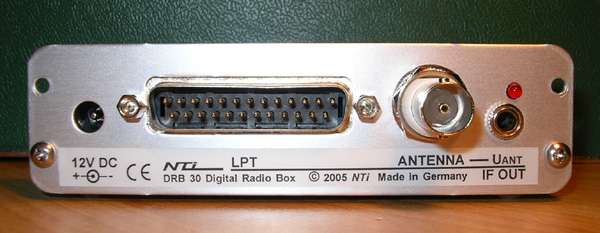
The DRB30 is packaged into an aluminium case sized 113 x 60 x 34 mm (w x d x h) . The back side panel provides a 12 DC power supply jack, a DB25 port for the PC link, a BNC antenna input and a 1/8" (3.5mm) phone jack for connection to the soundcard.
Alternatively, both a universal wall power supply and a stabilized laboratory power supply were used with no detectable difference in reception quality. The device was controlled using a parallel modem cable. Audio from the DRB30 was wired to the line input of the PC's soundcard through an audio cable with male 3.5 mm connectors.
Frequency tuning was done using a software provided by the manufacturer, NTi. At the time of testing, the software was available for download in version 0.4.
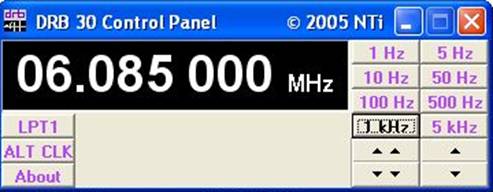
The receiving frequency can be typed in directly using the keyboard.
Future software versions should include the ability to tune in steps of 9
or 5 kHz commonly used below 30 MHz, as well as direct frequency control
via DREAM.
The following reception protocols were selected to represent some typical situations. DRM programs which could be received without problems are not shown. Such a station would be the virtually local station DLF on 855 kHz, which could be received during the whole test period with about 100% audio decoding rate, at an SNR of approx. 28 dB. Instead, I try to show protocols of difficult reception conditions that challenged the receiver.

This is the reception log of BBC on 1296 kHz. Here, the DRB30 performed
better than the Elektor receiver, both with respect to SNR numbers as well
as audio decoding rate. The maximum SNR of 30.5 dB is a pretty good
highlight, taking into account the existing reception conditions. During
the test, the incoming signal fluctuated a lot more than is common on
mediumwave.
49 m Band Results

Given moderate conditions, the Elektor can quite keep
up with the DRB30. The results of long term observations taken with the
DRB30 are in the typical range of today's receivers.
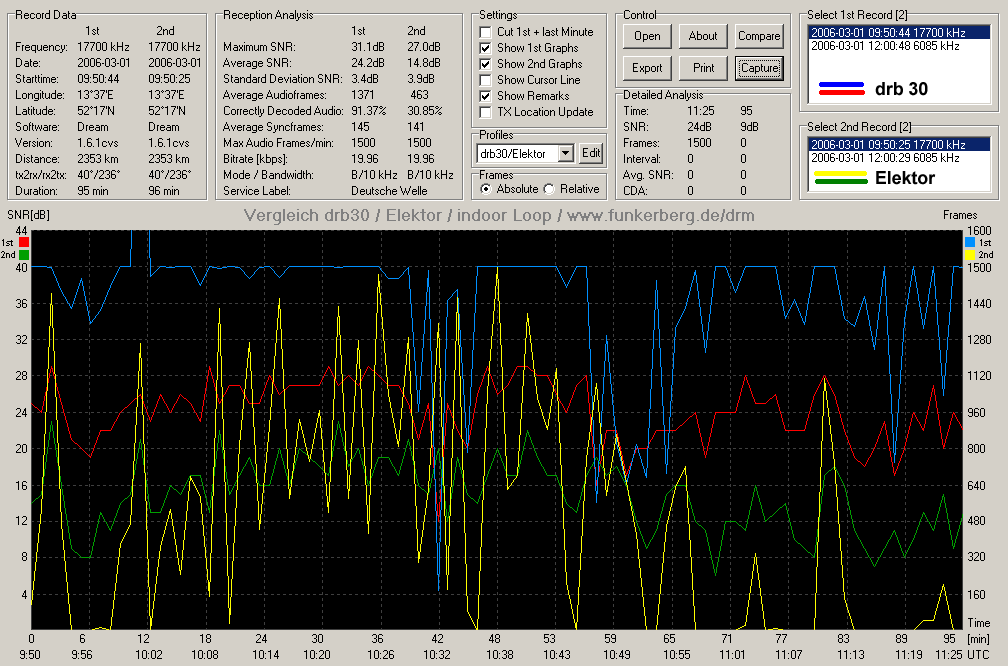
Here's a very nice log illustrating the capabilities of
the DRB30. During the test, significant fading was observed, which was
much better compensated by the DRB30. The DRB30 excels with its well
working AGC and its large dynamic range.
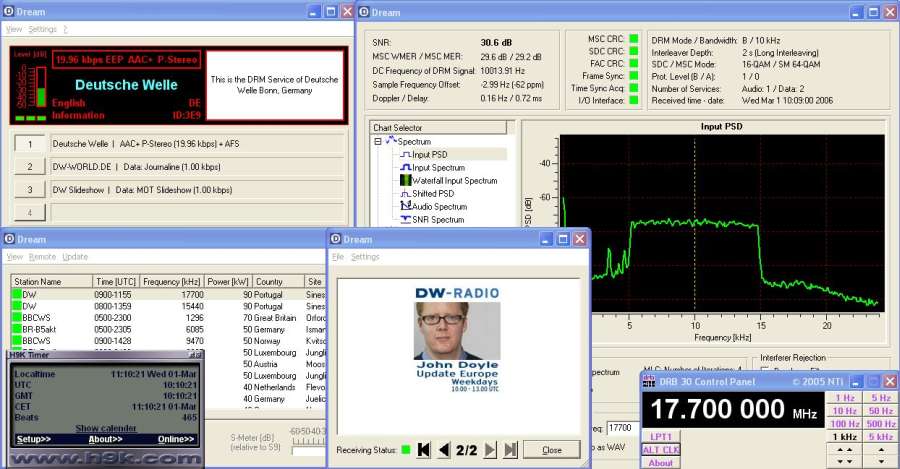
DRM reception as you whish it to be - a clean signal, steady audio decoding and datacasting.
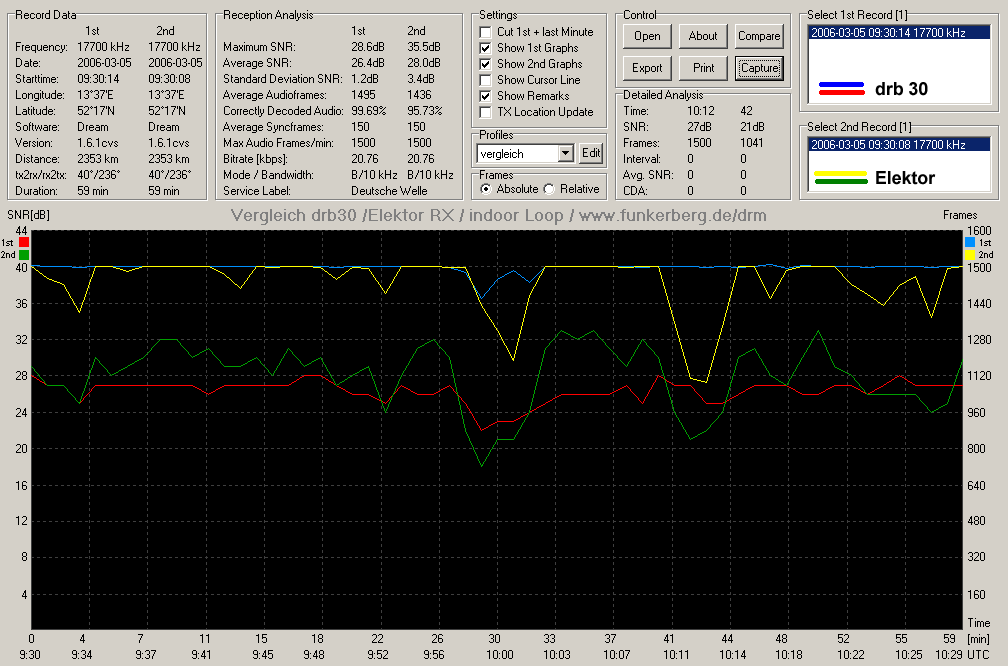
This example shows that propagation conditions on shortwave may vary
significantly. Here, the DRB30 was fed by a long wire aerial installed
under the roof. Steady operation at about 100% audio was achieved. The
Elektor receiver got its signal from an indoor loop antenna, its partly
higher SNR did not always produce better output results, as the audio
chart clearly shows.
Antennas
DRB30 doesn't seem to know what overloading is. Whether you use a small stub antenna, a magnetic loop or a provisional 12 m long wire, the DRB30 shows convincing results with all of them. Even in case of reception of a local station, using an overly long antenna, it didn't show any signs of intermodulation.
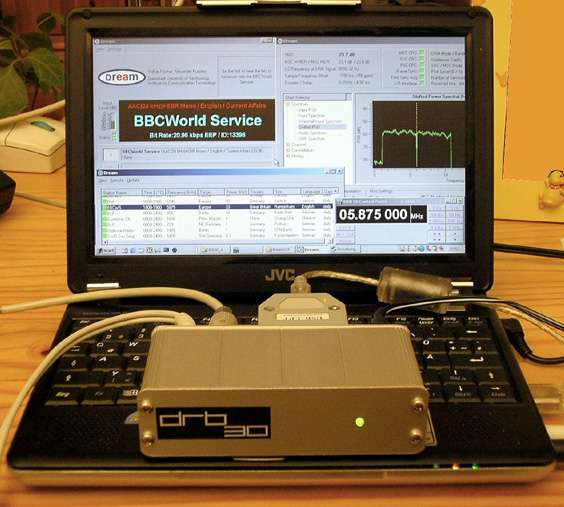
The DRB30 is extremely immune to interference. When put directly on a
notebook powered by a switching power supply, it shows normal reception
results - many receivers would quit working in such a situation.
Centre Frequency and Bandwidth
The center frequency of the audio IF output of the DRB30 amounts to about 10 kHz. The receiver has a quite large bandwidth of 15 kHz, so it seems well-prepared for hopefully higher bandwidth DRM signals of the future. The large bandwidth can lead to the effect, that, eg while receiving B5 at 6085 kHz, DREAM may synchronize itself to the 6095 kHz signal broadcast by RTL.
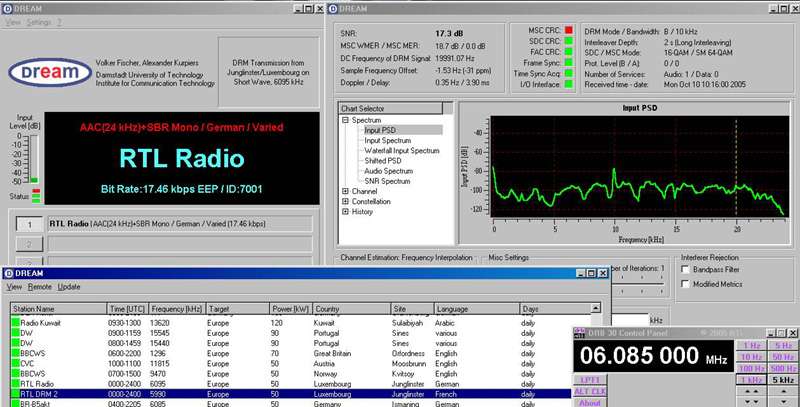
This is not a problem, though: DREAM can be
started with various options by double-clicking a small batch file. You
may call this file start.bat. Make it contain a single line:
dream -E 10000 -S 2000
The option -E defines the centre frequency, -S is the bandwidth of the search window. The example shown causes DREAM to search for DRM signals only in a range from 9 kHz to 11 kHz.
|
Alternatively, you may enter the DREAM start options into the
properties panel of a shortcut pointing to dream.exe.
For this purpose, create a shortcut of Dream.exe and put it onto the desktop. Now, with a right mouse click, open the properties panel of the shortcut and enter the options at the shown place. Starting DREAM up this way has another nice effect - synchronization works much faster.
|
|
DRB30 and AGC
The final tests were carried out using a release model from the DRB30 2006' series. Compared to the pilot prerelease model, the final version has been updated and tuned especially for DRM reception. This completely solved the problems, which in a previous test carried out in autumn 2005, using the pre-production model, had lead to a slightly degraded SNR in certain DRM reception situations.
Connected to a 12 V supply, the DRB30 consumes a constant current of 160 mA. No differences could be observed using either a universal or a laboratory power supply.
Due to its small size, the DRB30 is well-suited for mobile operation. If you have enough room for the notebook, the receiver will not add much to its size. Disadvantages are the need for an external power supply and the quite bulky DB25 cable. Not to mention the fact that a growing number of small notebooks come without a parallel port.
While the power supply issue remains to be solved in a future version of the receiver, for example by means of a USB interface, at least the second issue can be solved easily. What is needed is a USB/parallel port adapter. Unfortunately, unlike the excellent USP/parallel port adapter from Henrik Haftmann, the no-name USB/printer adapter that was available, could not be made to work.
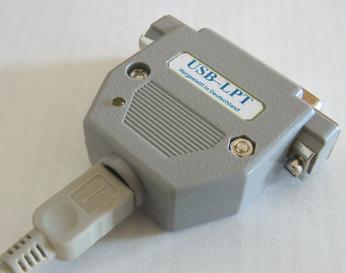
Once configured properly, the DRB30 could be controlled without problems.
The antenna input of the DRB30 can provide the power required for an active antenna. This feature is configurable by a jumper. The current drawn should not exceed 10 mA. The manufacturer proposes to use the following circuit:
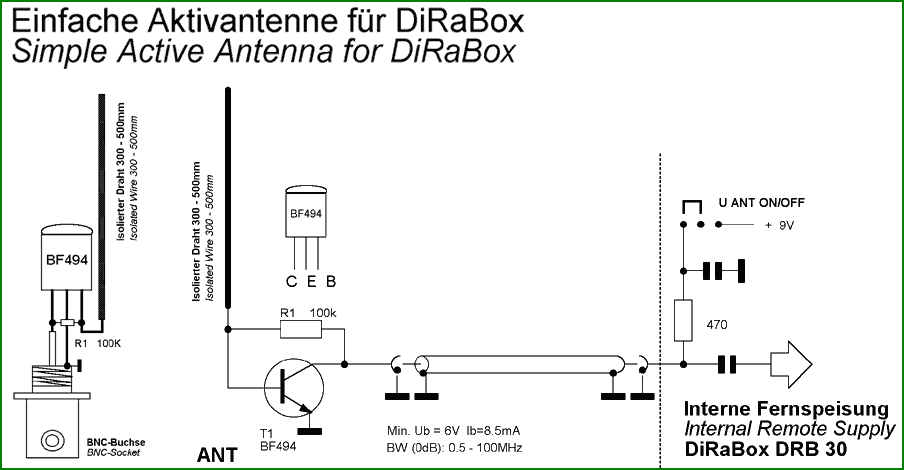
The DRB30 is a small-form-factor, well-built receiver, providing everything needed for successful DRM reception. It works well with various antenna solutions. Thanks to its 15 kHz bandwidth, it is well-prepared for future applications. A well working AGC and the large dynamic range allow for excellent DRM reception. Direct frequency input is another advantage of the receiver.
Frequency control via the parallel port however is a disadvantage. The software should be extended with respect to frequency spacing and station memory.
At this point I'd like to thank NTi for providing the test device. Credit is extended to Roland and the forum members for all the kind answers to my questions.
NTi (Rudolf Ille
Nachrichtentechnik), Manufacturer of the DRB30
http://www.nti-online.de/dirabox.htm
USB/Parallel Port Adapter by Henrik Haftmann
Search for usb2lpt at google, or
http://www-user.tu-chemnitz.de/~heha/bastelecke/Rund%20um%20den%20PC/USB2LPT/
Useful information about DRM radio, generally great
radio forum
http://www.ukwtv.de
A discussion forum all about DRM
http://www.drmrx.org/forum/
DRM internet site of the author
http://www.funkerberg.de/drm
